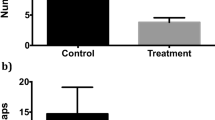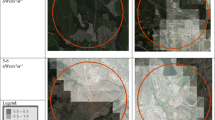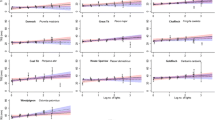Abstract
Artificial night lighting is one of the least studied outcomes of urbanization. While the effects of night lighting on mammals and their habitats seem obvious, they remain difficult to quantify. By reviewing laboratory and field studies conducted on mammals since 1943, this paper summarizes the most salient effects of artificial night lighting on activity patterns and behavior. These studies assist us in generating hypotheses regarding the effects of lights, erected across the militarized U.S.-Mexico border, on the endangered Ocelot and its nocturnal prey. We predict that activity patterns for Ocelots and their nocturnal prey would be altered under artificial night lighting conditions. Specifically, evening activity levels would either be reduced or redirected towards areas with dense vegetation. In addition, Ocelot foraging success would likely be altered as a result of turning night into day. Recommendations are made for Ocelot recovery and future research on surrogate species.
Similar content being viewed by others
References
Beier, P. (1995) Dispersal of juvenile cougars in fragmented habitat. Journal of Wildlife Management 59(2), 228–237.
Bisbal, F.J. (1986) Food habits of some neotropical carnivores in Venezuela (Mammalia, Carnivora). Mammalia 50, 329–339.
Blair, F.W. (1943) Activities of the Chihuahua deer-mouse in relation to light intensity. Journal of Wildlife Management 7, 92–97.
Bruseo, J.A. and Barry Jr., R.E. (1995) Temporal activity of synoptic Peromyscus in the central Appalachians. Journal of Mammalogy 76, 78–82.
Bureau of Citizenship and Immigration Services. (2002) McAllen border patrol sector. http:// www.immigration.gov/graphics/shared/fieldoffices/sectors/Mcallen/aboutus.htm viewed 2/24/2003.
Bureau of Citizenship and Immigration Services. (2002) Overview of the U.S. border patrol. http:// www.immigration.gov/graphics/shared/lawenfor/bpatrol/overview.htm viewed 2/25/2003.
Clarke, J.A. (1983) Moonlight's influence on predator/prey interactions between short-eared owls (Asio flammeus) and deermice (Peromyscus maniculatus). Behavioral Ecology and Sociobiology 13, 205–209.
Davis, W.B. and Schmidly, D.J. (1997) The mammals of Texas: Online edition. http://www.nsrl.ttu.edu/ tmot1/Default.htm viewed 12/20/02.
De Villa Meza, A., Meyer Martinez, E. and Lopez Gonzalez, C.A. (2002) Ocelot (Leopardus pardalis) food habits in a tropical deciduous forest of Jalisco, Mexico. American Midland Naturalist 148, 146–154.
Emmons, L.H. (1987) Comparative feeding ecology of felids in a neotropical rainforest. Behavioral Ecology and Sociobiology 20, 271–283.
Emmons, L.H., Sherman, P., Bolster, D., Goldizen, A. and Terborgh, J. (1989) Ocelot behavior in moonlight. In Advances on Neotropical Mammalogy (K.H. Redford and J.F. Eisenberg, eds.), pp. 233–242. The Sandhill Crane Press, Inc., Florida.
Grigione, M.M., Caso, A., List, R. and Gonzalez-Lopez, C. (2001) Status and conservation of endangered cats along the U.S.-Mexico border. The Endangered Species Update 18, 129–132.
Kaufman, D.W. and Kaufman, G.A. (1982) Effect of moonlight on activity and microhabitat use by ord's kangaroo rat (Dipodomys ordii). Journal of Mammalogy 63(2), 309–312.
Kavanau, J.L. (1968) Activity and orientational response of white-footed mice to light. Nature 218, 245–252.
Kavanau, J.L. and Havenhill, R.M. (1976) Compulsory regime and control of environment in animal behavior. Light level preferences of small nocturnal mammals. Behavior 59, 203–225.
Kavanau, J.L. and Rischer, C.E. (1968) Program clocks in small mammals. Science 161, 1256–1259.
Konecny, M.J. (1989) Movement patterns and food habits of four sympatric carnivore species in Belize, Central America. In Advances on Neotropical Mammalogy (K.H. Redford and J.F. Eisenberg, eds.), pp. 243–264. The Sandhill Crane Press, Inc., Florida.
Laack, L.L. (1991) Ecology of the ocelot (Felis pardalis) in south Texas. Master's Thesis. Texas A&I University, Texas.
Lockard, R.B. and Owings, D.H. (1974) Seasonal variation in moonlight avoidance by bannertail kangaroo rats. Journal of Mammalogy 55(1), 189–193.
O'Farrell, M. (1974) Seasonal activity patterns of rodents in a sagebrush community. Journal of Mammalogy 55, 809–822.
Price, M., Waser, V., Nickolas M. and Bass, T.A. (1984) Effects of moonlight on microhabitat use by desert rodents. Journal of Mammalogy 65(2), 353–356.
Shindle, D.B. (1995) Habitat use of ocelots in the Tamaulipan biotic province. Master's Thesis. Texas A&M University, Texas.
Strayhorn, C.K.Window on state government: The south Texas border region. June 2002 update. Texas comptroller of public accounts. Http://www.window.state.tx.us/ecodata/regional/stxborder/outlook.html viewed 3/4/2003.
Tewes, M.E. and Everett, D.D. (1986) Status and distribution of the endangered ocelot and jaguarondi in Texas. In Cats of the World: Biology, Conservation, Management (S.D. Miller and D.D. Everett, eds.), pp.147–158. National Wildlife Federation, Washington, D.C.
Tewes, M.E. and Shindle, D.B. (1997) Factors influencing activity patterns of ocelots. In Current Research of the Caesar Kleberg Wildlife Research Institute July1, 1996 to June 30, 1997 (A.M. Fedynich, ed.), p. 31. Texas A&M University-Kingsville, Texas.
Tewes, M.E., Young, J., Laack, L.L. and Hayslette, S.E. (1997) Dietary overlap of co-occurring ocelots and bobcats. In Current Research of the Caesar Kleberg Wildlife Research Institute July1, 1996 to June 30, 1997 (A.M. Fedynich, ed.), p. 37. Texas A&M University-Kingsville, Texas.
U.S. Fish and Wildlife Service. (1982) Endangered and threatened wildlife and plants; endangered status for the U.S. population of the ocelot. Federal Register 47, 31670–31672.
U.S. Fish and Wildlife Service. (1990) Listed cats of Texas and Arizona (with emphasis on the ocelot). U.S. Fish and Wildlife Service, New Mexico.
U.S. Fish and Wildlife Service. (2002) Draft biological opinion for operation Rio Grande. U.S. Fish and Wildlife Service, Texas.
Wolfe, J.L. and Summerlin, C.T. (1989) The influence of lunar light on nocturnal activity of the old-field mouse. Animal Behaviour 37, 410–414.
Author information
Authors and Affiliations
Rights and permissions
About this article
Cite this article
Grigione, M.M., Mrykalo, R. Effects of artificial night lighting on endangered ocelots (Leopardus paradalis) and nocturnal prey along the United States-Mexico border: A literature review and hypotheses of potential impacts. Urban Ecosystems 7, 65–77 (2004). https://doi.org/10.1023/B:UECO.0000020173.70355.ab
Issue Date:
DOI: https://doi.org/10.1023/B:UECO.0000020173.70355.ab




